If you are new to investing, you might have come across the term “robo-investing” in your preliminary research, and you may be wondering what it is, and whether or not it might be the right vehicle for you.
Robo-advisors are automated investment platforms that use algorithms to create and manage investment portfolios. They have become increasingly popular in recent years, as they offer a low-cost and convenient way to invest.
But are they trustworthy? Can they be as reliable as a human advisor?
The answer is yes, robo-advisors can be trustworthy. They are regulated by the Securities and Exchange Commission (SEC), which means that they are subject to certain standards of conduct. Additionally, robo-advisors use algorithms to make investment decisions, which means that they are not subject to human emotion or bias.
However, it is important to do your research and choose a robo-advisor that is reputable and has a good track record. There are many robo-advisors available, so it is important to compare their fees, features, and services before making a decision.
Here are some tips for choosing a robo-advisor:
- Consider your investment goals. What are you hoping to achieve with your investments? Are you saving for retirement, a down payment on a house, or something else?
- Compare fees. Robo-advisors charge different fees, so it is important to compare them before making a decision.
- Consider the features and services offered. Some robo-advisors offer more features and services than others. Make sure to choose a robo-advisor that offers the features and services that are important to you.
- Read reviews. Once you have chosen a few robo-advisors, read reviews from other investors. This can help you get a better idea of what to expect from each robo-advisor.
By following these tips, you can choose a robo-advisor that is right for you.
Are robo-investment platforms trustworthy?

Should You Trust a Robot to Manage Your Money?
The first thing you will undoubtedly want to know is, “Is robo-investing a genuine, bone-fide investment platform?” This is an easy one to answer, and the answer is yes – it is. In fact some of the most trusted and popular wealth management companies, like Moneyfarm and Wealthfront for example, operate their own, bespoke robo-investment platforms.
The key thing about basic robo-investment platforms, like the one operated by companies like Wealthfront; is that they are totally automated. Now before you ask the question, “Aren’t they all?” – The answer is no, they are not. There can be various degrees of human intervention across the robo advisor sector, which is where someone like Moneyfarm, offer an interesting “halfway house.”
Who is best suited to working with a robo-advisor?

Why Robo-Advisors Fall Short with Diversification
Using a robo advisor is very popular among young and first time investors. Robo investment platforms are built on sophisticated tables of algorithms. These are designed to facilitate automatic rebalancing, tax loss avoidance, and initial portfolio design aimed at maximising returns on the investment.
The reason they are as popular as they are, is that they are very simple to use. So, if you are someone who wants to have minimal participation in maintaining the growth your investment, and you would rather have little or no human intervention, a robo advisor package offered by the likes of Wealthfront, will be ideal for you.
How management costs differ
Active Management Enters Robo-Advisor Platforms
When it comes to cost, a fully automated robo-investment platform, can cost as little as between 0.15% and 1% to run. This compares to anything from 1% to 3% for a traditional investment package with expert human management.
Controlled by a series of sophisticated algorithms
Because there is so little human intervention with basic robo-investing, it doesn’t require a team of investment experts to constantly monitor what is happening. This doesn’t mean though that your investment is just left where it is, come hell or high-water. The algorithms we mentioned earlier, automatically do the managing.
The advantages of using a traditional (non-robo) investment advisor
How Human Advisors Can Compete with Robo-Advisors
Although using a robo-advisor is gaining in popularity, the vast majority of investors feel more comfortable working with a traditional (non-robo) investment advisor. This is particularly the case if you are a person who values direct human contact.
The only contact you get with a robo-advisor tends to be limited to asking questions about the system itself. A non-robo advisor will field and address all of your questions and concerns about the performance of your portfolio.
With a robo platform, once your appetite or aversion to risk has been established, that’s pretty much it. Your portfolio will be assembled and there will be little or no room for movement. On the other hand, a traditional non-robo investment advisor will offer you flexibility.
Nurture your investment by commissioning a robo advisor with the human touch
A robo-investment platform that offers the human touch as well is a very interesting proposition. It offers the best of both worlds. In this situation, the robo-advisor has a human side, or to be more accurate; a human investment expert, who will keep any eye on your portfolio’s performance, intervene where necessary, and offer help and advice when you call.
This is the sort of robo-investment platform that scores on all fronts. A supervised robo platform you can talk to someone about; that has flexibility, and that is offered at rates more closely akin to fully static, automated platforms.